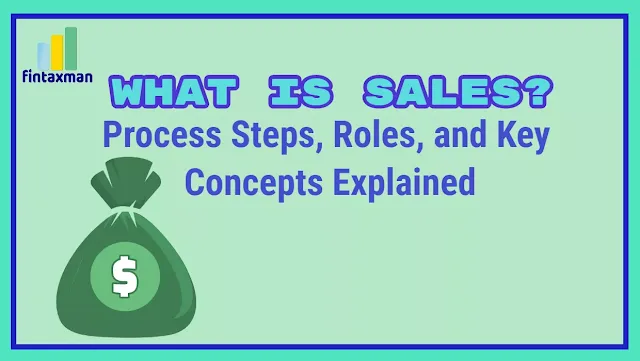Sales
A sale is the act of selling a product or service in exchange for money or other compensation. It marks the completion of the prospecting stage and often signifies the beginning or continuation of an ongoing relationship between a customer and a vendor.
Sales is a vital subsystem within marketing management. While sales and marketing often work closely together, they are fundamentally different functions that require distinct skill sets.
In simple terms, a sale is a transaction between two parties in which the buyer receives goods (tangible or intangible), services, or assets in exchange for payment. It can also refer to an agreement between a buyer and a seller on the price and terms of a security or financial asset.
Sales Process
- Prospecting / Initial Contact - This is the first step, where potential customers (leads) are identified. It involves researching and targeting individuals or businesses who may have a need for the product or service.
- Pre-Approach – Planning the Sale Before reaching out, the salesperson gathers relevant information about the prospect to tailor the sales strategy. This planning phase helps in understanding the customer’s needs, challenges, and buying behavior.
- Approach - The salesperson makes initial contact with the prospect. This could be through a phone call, email, social media, or a face-to-face meeting. The goal is to make a positive first impression and open the door for a deeper conversation.
- Need Assessment - Through active listening and asking insightful questions, the salesperson uncovers the prospect’s specific needs, pain points, and objectives. This step is critical in offering a relevant solution.
- Presentation - A tailored presentation or demonstration is given to show how the product or service meets the identified needs. This stage focuses on the benefits and value the offering provides.
- Meeting Objections - Prospects often have concerns or objections. The salesperson must address these confidently and clearly, providing additional information, reassurance, or alternatives to overcome resistance.
- Gaining Commitment - Once the objections are resolved, the salesperson asks for the sale. This could involve negotiating terms, finalizing details, or signing a contract.
- Follow-Up - After the sale, follow-up ensures customer satisfaction, builds long-term relationships, and opens opportunities for repeat business or referrals. This step is essential for customer retention and loyalty.
The Seller or Salesperson
Sales Agents
- Sales Broker / Seller’s Agent / Seller’s Representative - This is the traditional role of a salesperson who represents the seller or a company providing goods or services. The agent works to promote the seller’s interests and close deals on their behalf.
- Buyer’s Broker / Buyer Brokerage - In this arrangement, the salesperson represents the buyer, typically in larger or more complex transactions. Their duty is to find the best terms for the buyer and negotiate favorable conditions.
- Disclosed Dual Agent - A disclosed dual agent represents both the buyer and the seller in the same transaction. Their role is to act as a neutral intermediary, ensuring that both parties are treated fairly and that the deal proceeds with transparency and honesty. Full disclosure and consent from both parties are required.
- Transaction Broker - A transaction broker does not represent either party. Instead, they manage the administrative aspects of the transaction, ensuring that all documents are properly completed and processed. They have no fiduciary responsibility to advocate for fairness or honesty—only to facilitate the transaction.
- Sales Outsourcing - This involves external representatives who are contracted by a company to sell on its behalf. These agents are employed and managed by an outside firm but represent the client's brand directly. They are often held to quotas and report their activities back to the client, functioning as a virtual extension of the client’s sales force.
- Sales Manager - Sales managers develop and implement sales strategies to boost revenue and performance. They coordinate the efforts of the sales and marketing teams, monitor agent performance, and ensure ethical and efficient execution of the sales process. They play a key role in training, mentoring, and enforcing company standards.
- Salesperson - The primary role of a salesperson is to generate and close leads, identify customer needs, educate prospects, and deliver solutions that result in satisfied, long-term customers. Key responsibilities include:
- Questioning: Understanding the customer’s goals and requirements related to the product or service.
- Solution Creation: Communicating value and aligning offerings with customer needs at an economically viable cost.
FAQ's
What’s the difference between a salesperson and a sales agent?
A salesperson is generally focused on generating leads, presenting solutions, and closing deals. A sales agent, on the other hand, may represent either the buyer or seller (or both), and could take on more strategic or transactional roles in the sales process depending on the arrangement.
Is a sale legally binding before payment is made?
Yes. A sale becomes legally binding once there is mutual consent and ownership has been transferred. Payment can be made afterward, but the buyer is legally obligated to fulfil the agreed payment terms.
What is the role of a sales manager?
Sales managers oversee the sales team, develop strategies to increase performance, manage targets, train staff, and ensure that all agents or salespeople conduct sales fairly and ethically.
Can a single person represent both buyer and seller?
Yes, in the case of a disclosed dual agency, a salesperson may represent both parties in a transaction. However, full disclosure and consent from both sides are required, and the agent must remain neutral and fair.




